Drinking herbal tea can be a natural remedy for joint pain relief. Herbal teas, like ginger and turmeric, contain anti-inflammatory properties that reduce swelling and discomfort. They're also packed with antioxidants that protect your joints and improve circulation. Plus, herbal teas are caffeine-free, making them a soothing option for any time of day. By choosing low-calorie herbal blends, you promote healthier habits. Whether you stick to one kind or mix various herbs, you'll enjoy the benefits they offer. There's much more to discover about how to maximize these teas for your joint health.
Benefits of Herbal Tea
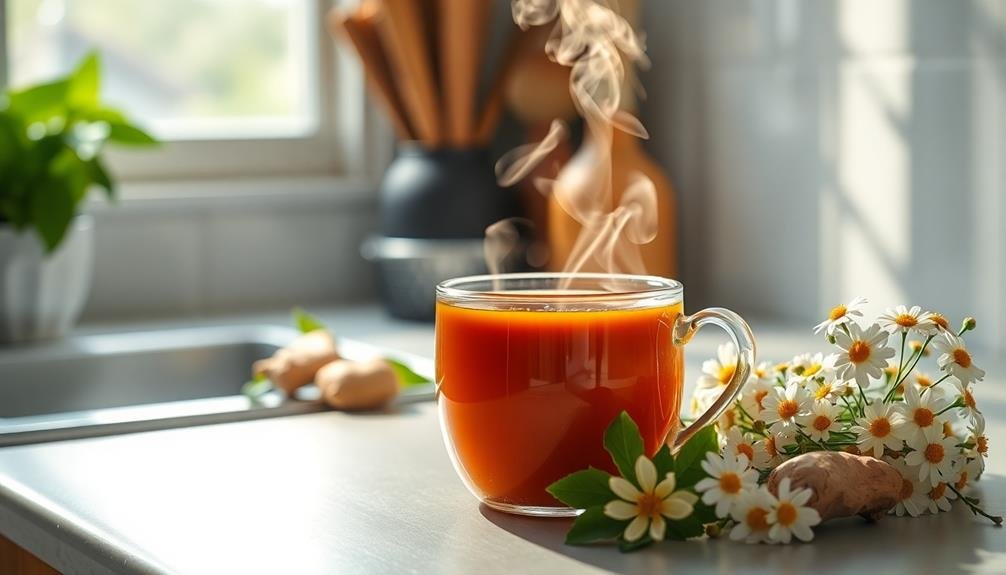
Herbal tea offers a multitude of benefits that can support your overall health, especially when it comes to joint pain relief. When you incorporate herbal tea into your daily routine, you're not just enjoying a warm beverage; you're also giving your body a natural source of hydration. Staying hydrated is essential for joint health, as it helps maintain the lubrication in your joints.
Moreover, many herbal teas contain antioxidants, which can play an important role in reducing inflammation. By drinking these teas regularly, you may notice a decrease in swelling and discomfort in your joints.
The calming effects of herbal tea can also promote relaxation, allowing you to better cope with chronic pain. You'll appreciate that herbal tea is generally caffeine-free, making it a suitable option for those sensitive to caffeine's stimulating effects.
This means you can enjoy a soothing cup any time of day without worrying about disrupted sleep patterns. Finally, herbal tea can be a delightful, low-calorie alternative to sugary drinks, helping you make healthier choices overall.
Key Ingredients for Relief
When you're looking for natural relief from joint pain, certain herbal ingredients can make a significant difference.
Turmeric's anti-inflammatory properties, ginger's pain-relieving effects, and Boswellia's healing benefits are key players in herbal tea blends.
Let's explore how each of these ingredients can help you find comfort.
Turmeric's Anti-Inflammatory Properties
Turmeric is renowned for its powerful anti-inflammatory properties, making it a top choice for those seeking relief from joint pain. Its active compound, curcumin, plays an essential role in reducing inflammation and alleviating discomfort. When you incorporate turmeric into your herbal tea, you're not just enjoying a warm beverage; you're tapping into nature's remedy.
Here's how turmeric can help you:
- Reduces Swelling: Turmeric can lower the levels of inflammatory markers in your body, leading to reduced swelling in your joints.
- Eases Pain: By blocking certain enzymes that contribute to inflammation, turmeric can help lessen pain associated with arthritis and other joint issues.
- Boosts Overall Health: Regular consumption of turmeric may enhance your immune system, providing additional support in managing chronic conditions.
Adding turmeric to your herbal tea routine can be a simple yet effective way to combat joint pain.
Just remember, it's best to pair turmeric with black pepper to enhance absorption, making it even more beneficial. Enjoy a cup of turmeric tea, and feel the soothing effects it brings to your joints.
Ginger for Pain Relief
Ginger is another powerful ally in the fight against joint pain, thanks to its natural anti-inflammatory and analgesic properties. When you incorporate ginger into your herbal tea, you're tapping into a remedy that's been used for centuries to alleviate discomfort. The active compounds in ginger, like gingerol, help reduce inflammation, making it particularly effective for conditions like arthritis.
You can easily add ginger to your daily routine. Simply steep fresh ginger slices in boiling water for about 10-15 minutes, or opt for powdered ginger if that's more convenient. Drinking this herbal tea regularly can help ease pain and improve your overall joint health.
Not only does ginger help with pain relief, but it also promotes better circulation, which can further help reduce stiffness in your joints. Plus, its warming properties can provide immediate comfort, especially during colder months.
If you're looking for a natural way to combat joint pain, incorporating ginger into your diet is a great choice. Its benefits are numerous, and you might just find that a warm cup of ginger tea becomes your go-to remedy for relief.
Boswellia's Healing Benefits
Boswellia, often referred to as Indian frankincense, is a potent herb that can greatly contribute to joint pain relief. This remarkable herb has been used for centuries in traditional medicine, and its active compounds, known as boswellic acids, offer several benefits that can help you manage discomfort effectively.
Here are three key healing benefits of Boswellia:
- Anti-inflammatory Properties: Boswellia works by inhibiting pro-inflammatory enzymes, reducing swelling and pain in your joints. This makes it an excellent choice for those suffering from arthritis or other inflammatory conditions.
- Improved Mobility: Regular use of Boswellia can enhance joint flexibility and mobility. You'll find it easier to move around, which can greatly improve your quality of life.
- Pain Relief: Boswellia not only targets inflammation but also alleviates pain directly. Many users report a noticeable reduction in pain levels, allowing them to engage in daily activities without discomfort.
Incorporating Boswellia into your herbal tea routine can be a game-changer for managing joint pain.
Try it and experience the benefits firsthand!
Popular Herbal Teas
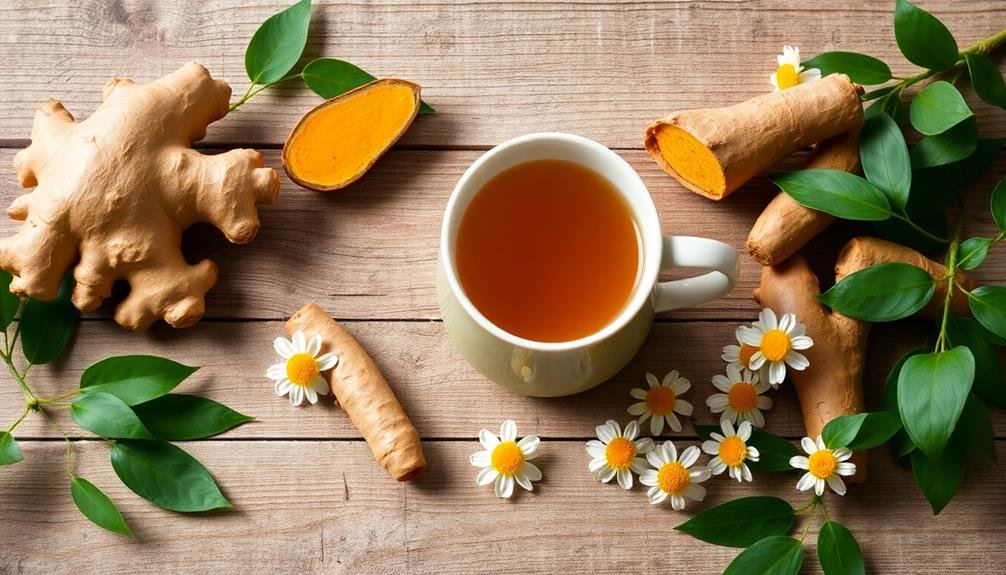
When you seek relief from joint pain, the comforting embrace of herbal teas can offer both solace and support. Several popular herbal teas stand out for their potential benefits.
Ginger tea is a favorite among many, known for its anti-inflammatory properties. It can help reduce swelling and discomfort, making it a go-to option for joint pain relief.
Turmeric tea, infused with the powerful compound curcumin, also packs a punch against inflammation. This vibrant yellow drink can brighten your day while soothing your joints.
Another wonderful choice is chamomile tea. Not only does it promote relaxation, but it may also help reduce pain associated with arthritis.
You might also enjoy nettle tea, which has been used for centuries to alleviate joint pain and improve mobility.
Lastly, peppermint tea can provide a rejuvenating twist and may help ease pain through its natural cooling effect.
By incorporating these herbal teas into your routine, you can create a warm, comforting ritual that supports your journey toward joint pain relief.
Explore these options and find the ones that resonate with you, enhancing both your wellness and your enjoyment of tea.
How Herbal Tea Works
Herbal tea works by harnessing the natural properties of various plants, offering a holistic approach to alleviating joint pain. When you sip these soothing brews, you're not just enjoying a warm drink; you're tapping into the benefits of nature's remedies.
Here's how herbal tea can help:
- Anti-inflammatory Effects: Many herbs, like ginger and turmeric, contain compounds that reduce inflammation. By drinking these teas, you may find relief from swelling and discomfort in your joints.
- Antioxidant Properties: Herbal teas are rich in antioxidants, which combat oxidative stress in your body. This can help protect your joints from damage and may slow down the progression of joint issues.
- Improved Circulation: Certain herbal teas, such as peppermint and green tea, can enhance blood flow. Better circulation means more nutrients and oxygen reach your joints, promoting healing and comfort.
Preparing Your Herbal Blend
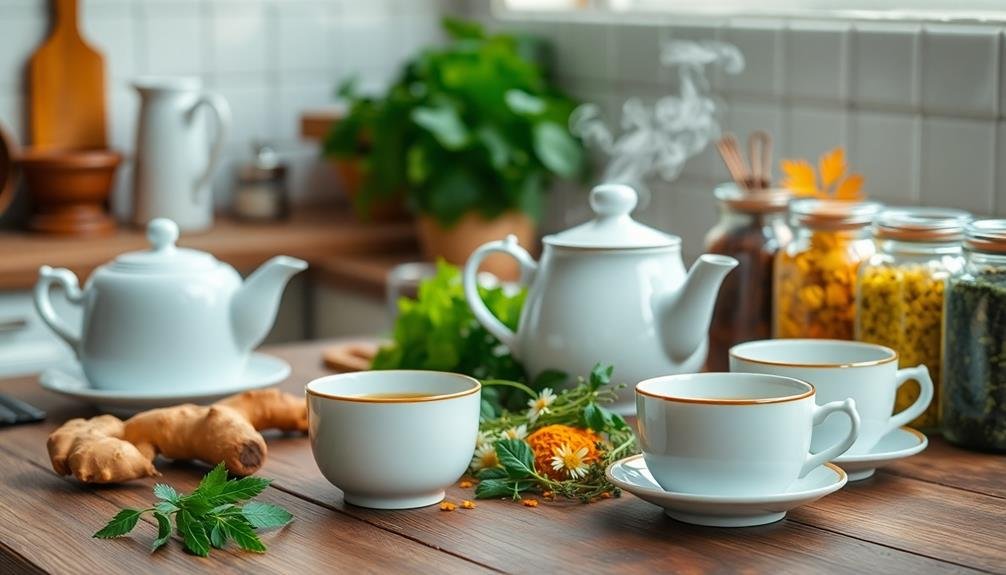
To experience the full benefits of herbal tea for joint pain relief, you'll want to prepare a blend that combines the right ingredients. Start by selecting herbs known for their anti-inflammatory properties.
Turmeric is a fantastic choice; its active compound, curcumin, helps reduce inflammation. Ginger is another great option, known for its pain-relieving qualities.
For added flavor and benefits, consider incorporating peppermint or chamomile, both of which can soothe discomfort. You can also include cinnamon, which may improve circulation and reduce swelling.
Once you've chosen your herbs, measure them out. A general guideline is to use about one to two teaspoons of dried herbs per cup of water. If you're using fresh herbs, you can increase that amount slightly.
Combine your selected herbs in a bowl and mix them thoroughly. This step guarantees you're getting a balanced blend that delivers the maximum benefits for joint pain relief.
Store your mixture in an airtight container to keep it fresh. When you're ready to brew, you'll have a personalized herbal blend at your fingertips, tailored to your specific needs!
Optimal Brewing Techniques
Brewing your herbal tea correctly is key to unfastening its full potential for joint pain relief. The right techniques can enhance the therapeutic properties of the herbs, making your experience more beneficial.
Here are three ideal brewing techniques to keep in mind:
- Use Fresh Ingredients: Always opt for fresh or high-quality dried herbs. They contain the most active compounds for pain relief. If you're using dried herbs, verify they're stored in a cool, dark place to maintain potency.
- Water Temperature Matters: Different herbs require different water temperatures. Generally, boiling water is great for sturdy herbs like ginger or turmeric, while delicate ones like chamomile do better with slightly cooler water. Aim for about 190°F for the best extraction.
- Steep Time: Don't rush the steeping process. Most herbal teas benefit from a steeping time of 5 to 15 minutes, depending on the herb. This allows the flavors and healing properties to fully infuse into the water.
When to Drink Herbal Tea
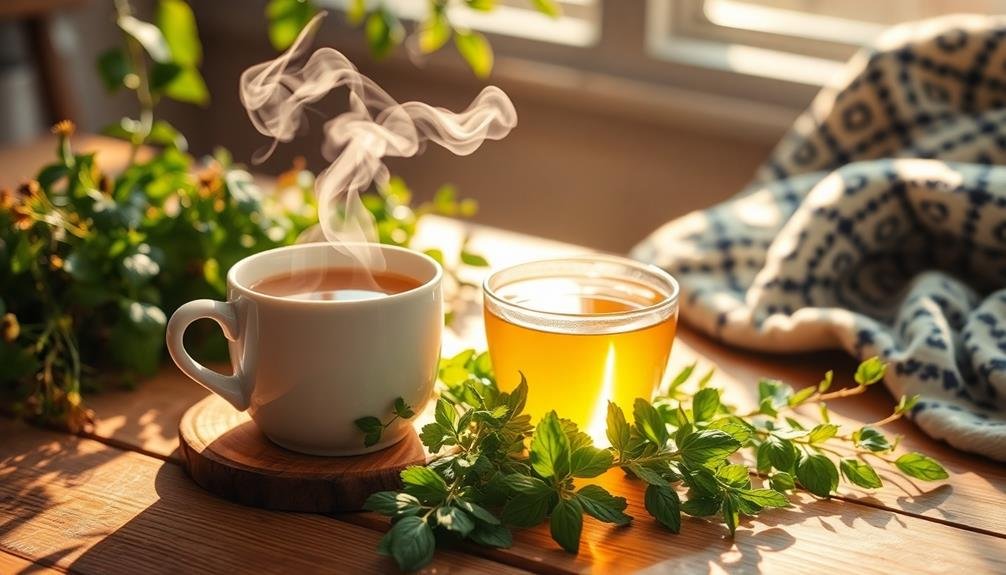
Knowing when to drink herbal tea can enhance its effectiveness for joint pain relief.
You might find it beneficial to incorporate it into your daily routine, whether you sip it before or after activities.
Timing your tea consumption can make a significant difference in how you feel throughout the day.
Best Times to Drink
Finding the right time to enjoy herbal tea can enhance its benefits for joint pain relief. Timing your tea consumption can maximize its soothing effects, helping you feel your best throughout the day. Here are three ideal times to sip your herbal brew:
- Morning Boost: Start your day with a warm cup of herbal tea to kick off your morning routine. Ingredients like ginger or turmeric can provide anti-inflammatory properties, setting a positive tone for the day ahead.
- Mid-Afternoon Break: When your energy dips, a cup of herbal tea can offer a revitalizing break. Opt for a blend with chamomile or peppermint to relax your muscles and ease any joint discomfort during those busy hours.
- Evening Wind-Down: Before bed, enjoy a calming herbal tea to help you unwind. Varieties like valerian root or lemon balm can promote relaxation, allowing your body to heal overnight, which is essential for joint recovery.
Daily Routine Incorporation
Incorporating herbal tea into your daily routine can be a simple yet effective way to manage joint pain. Start your day with a warm cup of herbal tea, such as ginger or turmeric, known for their anti-inflammatory properties. This morning ritual not only helps set a positive tone for the day but also prepares your body to tackle discomfort.
Consider having a cup mid-morning or afternoon. This timing allows you to take a break and refocus, while also providing additional relief from any pain that might arise as you go about your daily activities. Staying hydrated throughout the day is important, so keep a thermos of herbal tea handy.
If you find yourself feeling stiff or achy in the evening, sipping on chamomile or peppermint tea can help soothe your joints and promote relaxation before bedtime.
Establishing a consistent schedule for drinking herbal tea reinforces its benefits, making it a valuable part of your routine.
Pre- or Post-Activity
Drinking herbal tea before or after physical activity can greatly enhance your joint health and overall comfort. When you're active, your joints experience stress, and herbal tea can help manage that discomfort. You might wonder when the best time to sip your tea is.
Here are some key benefits for both pre- and post-activity consumption:
- Before Activity: Enjoying a cup of herbal tea like ginger or turmeric can reduce inflammation and boost circulation. This can prepare your joints for the strain of exercise, helping you feel more limber.
- During Activity: While hydration is vital, sipping on a mild herbal tea can provide antioxidants that support joint health. Consider a revitalizing peppermint tea to keep you energized and focused.
- After Activity: Post-activity, chamomile or green tea can aid in recovery. These teas help reduce soreness and inflammation, allowing your joints to recover more quickly.
Combining Ingredients
Combining the right ingredients can greatly enhance the effectiveness of herbal tea for joint pain relief. When you're looking to maximize your relief, consider blending herbs known for their anti-inflammatory properties. For instance, turmeric is a powerhouse due to its active compound, curcumin, which fights inflammation. Pair it with ginger, another anti-inflammatory herb, to amplify the benefits and add a nice zing to your tea.
You might also think about including peppermint or chamomile, both of which can promote relaxation and help ease muscle tension. Adding a splash of lemon can't only brighten the flavor but also provide a boost of vitamin C, which is essential for collagen formation and joint health.
Don't forget about the benefits of green tea. Rich in antioxidants, it can help combat oxidative stress in your joints.
Experimenting with these combinations can lead to discovering your perfect blend. Remember to adjust the proportions based on how your body responds, as everyone's preferences and needs are unique.
Storage Tips for Herbs
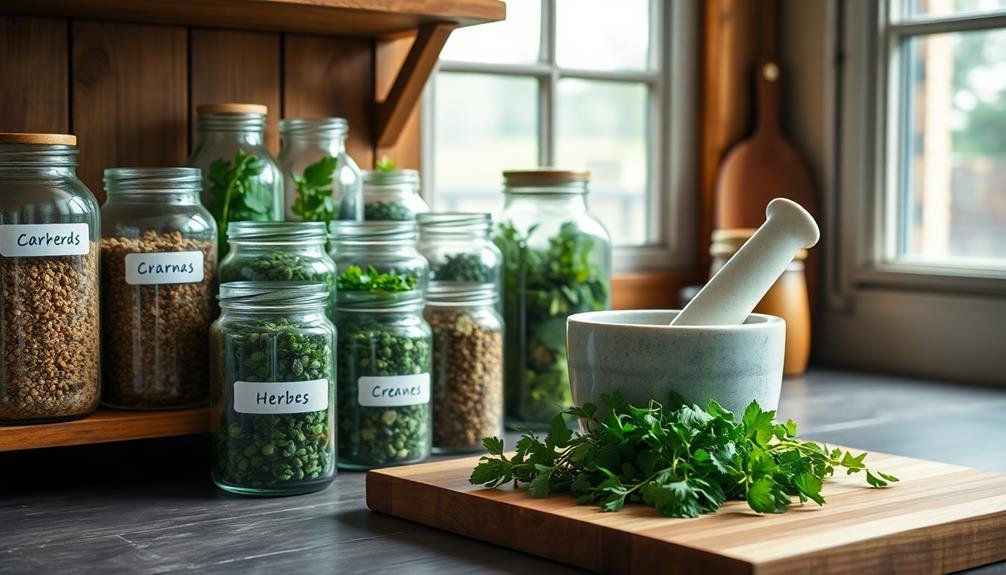
To keep your herbs fresh and potent, it's essential to choose the right container.
Aim for a cool, dark place to store them, as temperature can greatly impact their quality.
Proper Container Selection
When selecting containers for storing herbs, it's crucial to choose ones that protect their freshness and potency. The right container can make a significant difference in how long your herbs maintain their flavor and effectiveness.
Here are three key options to take into account:
- Glass Jars: Opt for dark glass jars with airtight lids. They block light, which can degrade herbs, and keep moisture out, ensuring your herbs stay dry and flavorful.
- Ceramic Containers: These are great for long-term storage. Look for ceramic jars with tight-fitting lids to prevent air exposure. They're not only functional but can also add a decorative touch to your kitchen.
- Food-Grade Plastic Containers: If you prefer lightweight options, choose food-grade plastic containers with seals that prevent air and moisture from entering. Make sure they're BPA-free to avoid any chemical leaching.
Ideal Temperature Conditions
Maintaining the right temperature for your herbs is vital for preserving their flavor and medicinal properties. Ideally, you should store your herbs in a cool, dark place. Heat can quickly degrade their quality, causing flavor loss and diminishing health benefits. A temperature range of 60 to 70 degrees Fahrenheit works best.
Avoid placing your herbs near heat sources like stoves, ovens, or direct sunlight, as these can raise the temperature and negatively impact the herbs. Instead, consider using a pantry or a cabinet away from appliances that generate heat.
If you live in a particularly warm climate, refrigeration can be a wise option, but keep in mind that moisture can also harm herbs, so make sure they're well-sealed.
For dried herbs, it's best to keep them in an airtight container to maintain a stable temperature and protect them from fluctuations.
If you're using fresh herbs, it's important to place them in a breathable container, like a paper towel or a cloth bag, to allow for airflow while preventing excess moisture buildup.
Shelf Life Guidelines
Properly storing your herbs not only preserves their flavor and medicinal properties but also extends their shelf life.
To make the most of your herbal tea ingredients, follow these simple storage tips:
1. Keep it Cool and Dark: Store your herbs in a cool, dark place, away from direct sunlight and heat sources. A pantry or a cupboard works well.
Light and heat can degrade the potency of your herbs over time.
2. Use Airtight Containers: Opt for airtight glass jars or containers to minimize exposure to air and moisture.
This prevents your herbs from losing their aroma and effectiveness. Make sure to label the containers with the date you stored the herbs for easy tracking.
3. Check for Freshness: Regularly inspect your herbs for any signs of spoilage, such as mold or off smells.
Most dried herbs have a shelf life of about 1-3 years, while fresh herbs should ideally be used within a week or two.
Safety and Precautions
Considering the potential benefits of herbal tea for joint pain relief, it's crucial to prioritize safety and precautions. Before you start incorporating herbal teas into your routine, check with your healthcare provider, especially if you're pregnant, nursing, or taking medications. Some herbs may interact negatively with prescription drugs or exacerbate existing health conditions.
Pay attention to the source of your herbal tea. Choose high-quality brands that practice safe harvesting and processing methods. Avoid products with added artificial ingredients or excessive sugar, as these can undermine the health benefits you seek.
Monitor your body's response to different herbal teas. If you experience any adverse reactions, such as allergic responses or digestive issues, discontinue use immediately.
It's also wise to start with small amounts to gauge how your body reacts before consuming larger quantities.
Lifestyle Tips for Joint Health
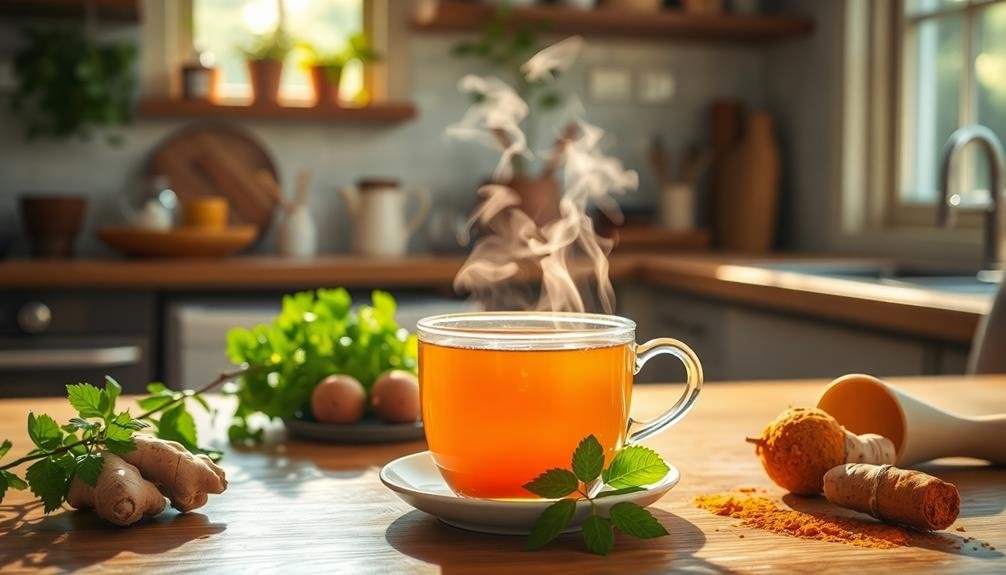
Joint health is essential for staying active and enjoying life to the fullest. You can take several practical steps to support your joints and enhance your overall mobility. Here are three lifestyle tips to reflect on:
- Stay Active: Regular exercise strengthens the muscles around your joints and helps maintain flexibility. Aim for low-impact activities like swimming, walking, or cycling to reduce stress on your joints while keeping them strong.
- Maintain a Healthy Weight: Carrying extra weight puts additional pressure on your joints, especially those in your hips, knees, and ankles. By adopting a balanced diet and incorporating physical activity, you can achieve and maintain a healthy weight, which supports joint health.
- Incorporate Joint-Supporting Foods: Focus on consuming foods rich in antioxidants, omega-3 fatty acids, and vitamins. Foods like leafy greens, fatty fish, nuts, and berries can help reduce inflammation and support overall joint function.
Personalizing Your Tea Blend
Finding ways to support your joints doesn't stop with lifestyle changes; herbal tea can also play a significant role. Personalizing your tea blend allows you to target specific joint issues while enjoying a comforting beverage.
Start by considering herbs known for their anti-inflammatory properties, like ginger and turmeric. They're great for reducing swelling and pain.
Next, think about adding herbs that promote overall joint health, such as nettle or alfalfa. Both are rich in nutrients that can help strengthen connective tissues.
If you prefer a soothing flavor, chamomile or peppermint can be excellent choices to calm your mind while aiding digestion.
You can also mix in some spices for added benefits. Cinnamon isn't only delicious but also boasts anti-inflammatory properties.
Feel free to experiment with different combinations until you find what you love. Remember to steep your blend for the recommended time to extract all the beneficial compounds.
Testimonials and Success Stories

Many people have found relief from joint pain through the soothing ritual of sipping herbal tea. Your experience with herbal tea might mirror those of others who've discovered its benefits.
Here are a few success stories that highlight how herbal tea can make a difference:
- Sarah, 54: After struggling with arthritis for years, she began drinking ginger and turmeric tea daily. Within weeks, she noticed a significant reduction in swelling and discomfort, allowing her to enjoy her favorite activities again.
- John, 47: He turned to chamomile tea to help manage his chronic joint pain. The calming effects not only eased his discomfort but also improved his sleep quality, making him feel more energetic and active during the day.
- Emily, 38: A lifelong athlete, she incorporated peppermint tea into her routine post-workout. The anti-inflammatory properties helped her recover faster, reducing soreness and keeping her joints flexible.
These testimonials show that sipping herbal tea can be a simple yet effective way to manage joint pain.
You too can find comfort and relief through this holistic approach, enhancing your overall well-being.
Frequently Asked Questions
Can Herbal Tea Replace Medication for Joint Pain Relief?
Herbal tea can complement your joint pain relief strategy, but it shouldn't replace prescribed medication without consulting your doctor. It may offer benefits, but you'll want a thorough approach for effective management.
Are There Any Side Effects of Drinking Herbal Tea?
When you drink herbal tea, you might experience mild side effects like digestive discomfort or allergic reactions. It's best to monitor how your body reacts and consult a healthcare professional if you have concerns.
How Long Does It Take to Feel Relief From Herbal Tea?
You might start feeling relief from herbal tea within 30 minutes to a few hours, depending on the type and your body's response. Consistent consumption can enhance its benefits over time, so be patient.
Can I Drink Herbal Tea if I Have Allergies?
Yes, you can drink herbal tea, but be cautious. Some herbs may trigger allergies. Always check the ingredients and consult your doctor if you're unsure. Choose allergy-friendly options to enjoy tea without worries.
Is It Safe to Drink Herbal Tea During Pregnancy?
It's generally safe to drink herbal tea during pregnancy, but you should choose caffeine-free options and avoid certain herbs. Always consult your healthcare provider to guarantee the tea you select is safe for you and your baby.
In Summary
Incorporating herbal tea into your routine can be a soothing and effective way to manage joint pain. With its anti-inflammatory properties and key ingredients, you can find relief while enjoying a warm cup. Remember to prepare your blend thoughtfully and stay mindful of any safety precautions. By personalizing your tea and combining it with healthy lifestyle choices, you'll be on your way to better joint health. So, brew that tea and embrace the comfort it brings!

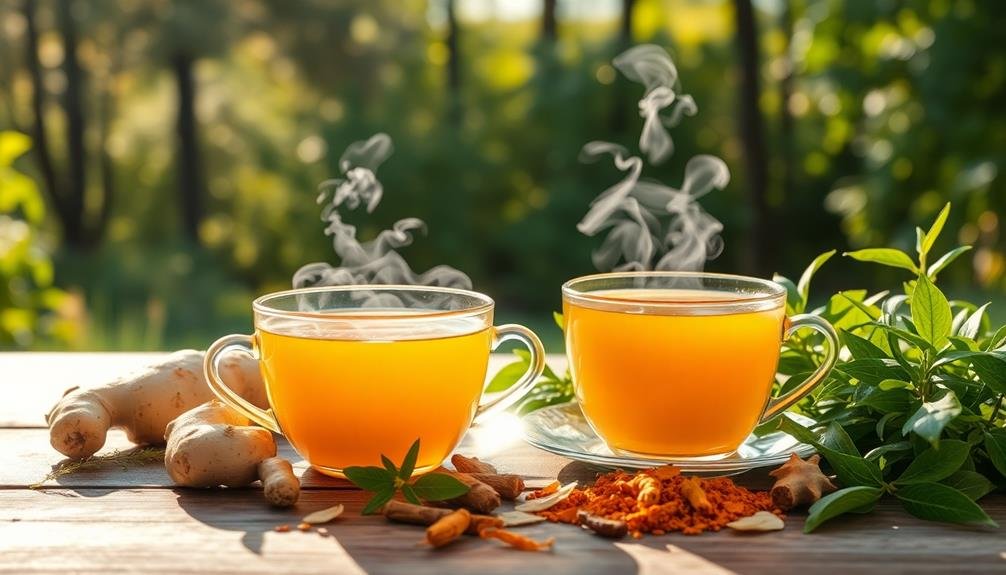
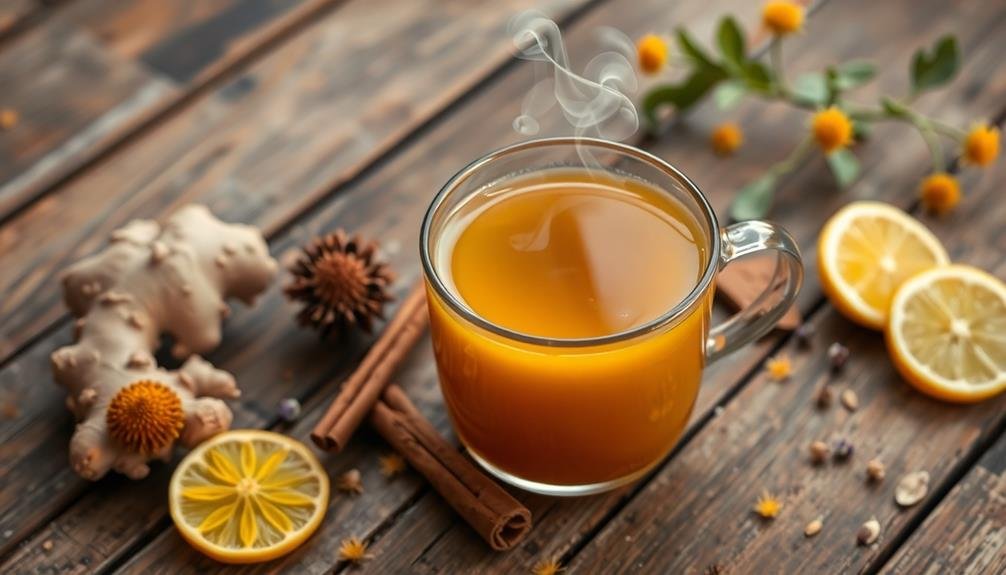
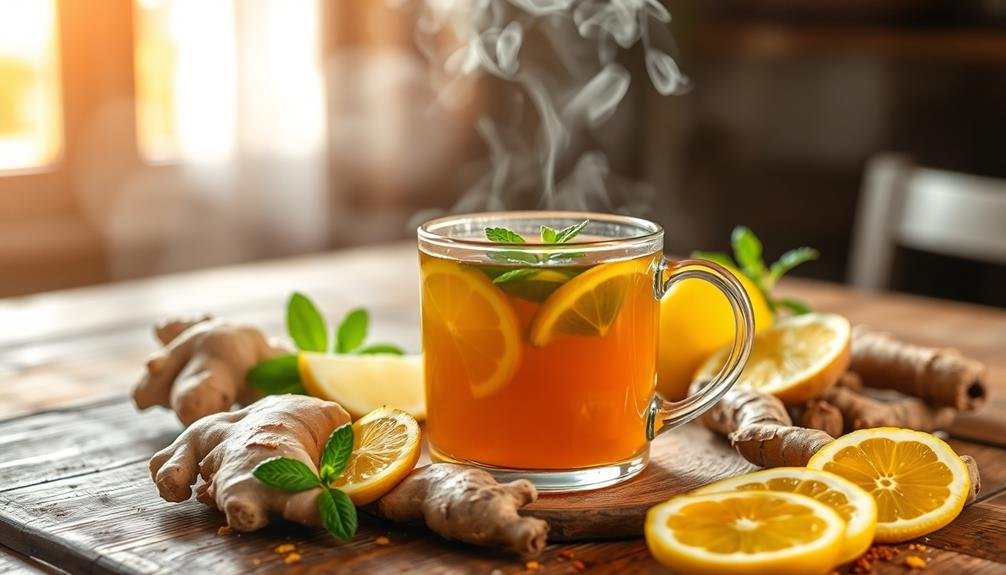
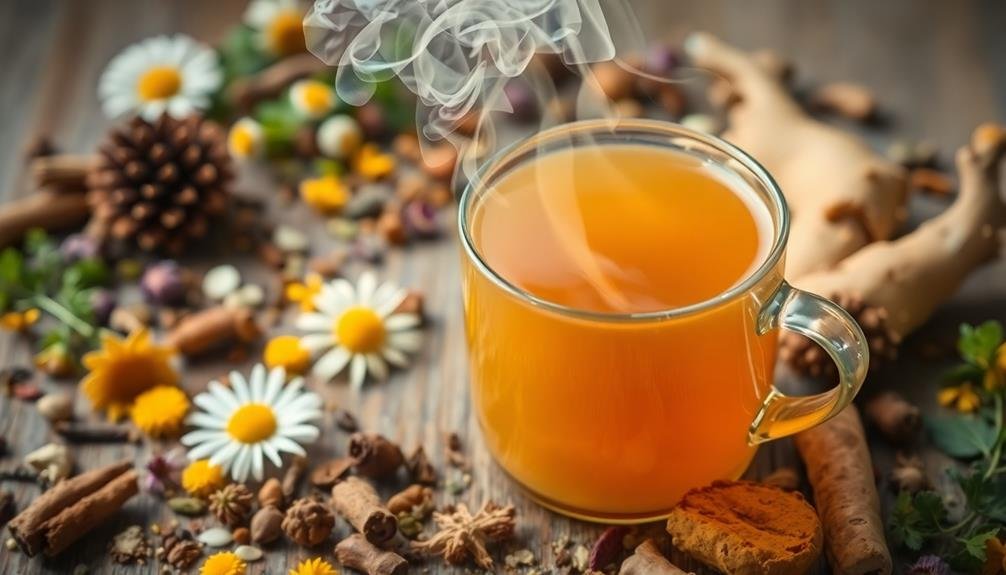
Leave a Reply